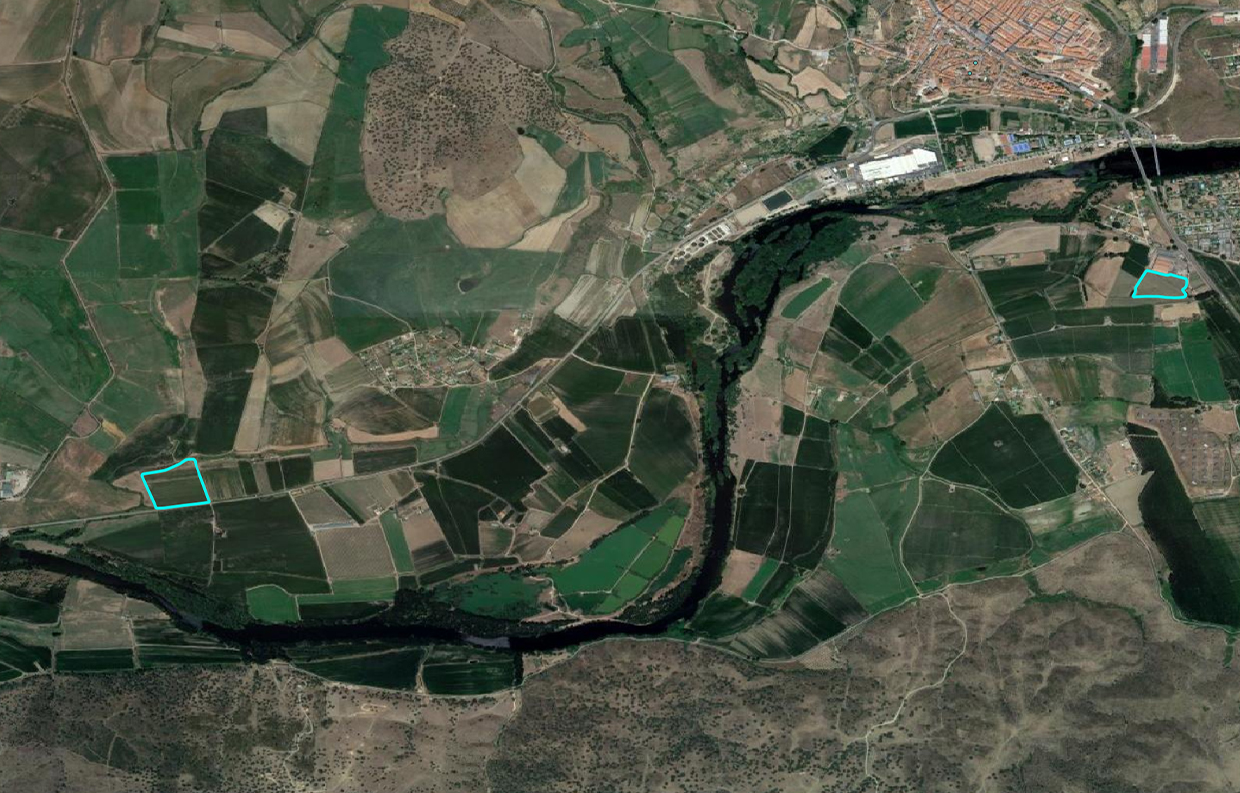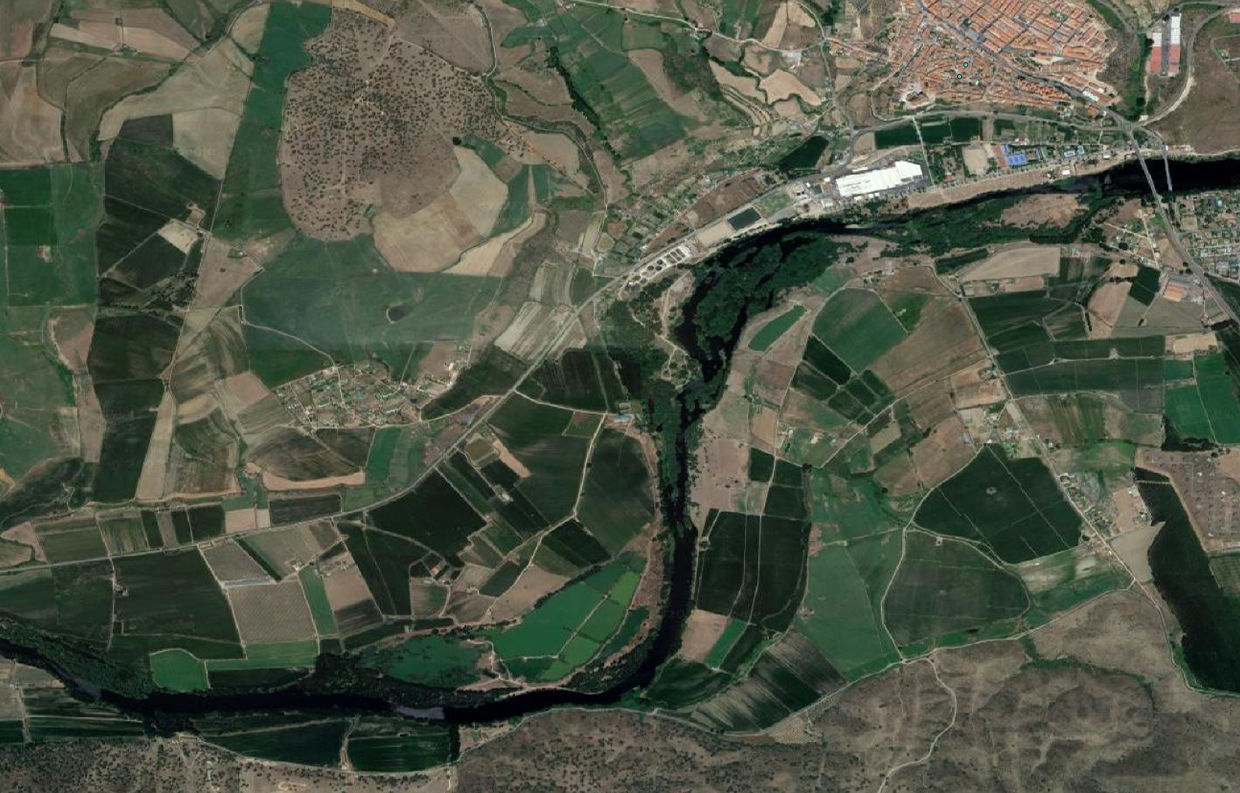
The map shows where the region is situated in Spain. Selected municipalities located within the province of Cáceres, which is a part of the autonomous region of Extremadura located in western Spain. It is known for its agricultural activities, including the cultivation of cereals, olives, grapes, and various fruits. But is also an important region for livestock farming.
Calzadilla, Casas de Don Gómez, Casillas de Coria, Coria, Gata, Guijo de Coria, Guijo de Galisteo, Holguera, Huélaga, Montehermoso, Moraleja, Morcillo, Pescueza, Portaje, Riolobos, Torrejoncillo. 16 of 223 municipalities.

Parts of Extremadura
Focus when it comes to biophysical constraints in the Spanish use case is the soil organic matter of the fields, followed by low pH and organic matter. Precipitation and temperature are secondary factors.
The marginal land surveyed at the regional scale was corn fields with a yield lower than 12 tonnes ww/ha (14% water content). Currently, continuous corn cultivation is common, but introducing kenaf and hemp into the crop rotation can diversify it. This change aims to enhance organic matter in the soil. The emphasis is on irrigated land, where industrial crops can reduce irrigation needs and increase soil organic matter. These crops must thrive in high temperatures and low precipitation.


Finca La Orden-Valdesequera
In 2023, 0,1 hectares of hemp and kenaf will be cultivated alongside traditional crops like tomatoes, maize, and peppers. This crop rotation strategy aims to reduce irrigation requirements, boost soil organic matter, and enhance overall crop yields.
Main Challenges
In the selected municipalities of northern Cáceres, continuous corn cultivation on irrigated land has led to reduced soil organic matter and degradation over time. The fields are also challenged by low pH and organic matter content. These biophysical constraints, along with the high temperatures and low precipitation, define the land as marginal. Enhancing soil health and biodiversity while maintaining agricultural productivity is a key regional challenge, particularly in light of increasing environmental stressors.
Socioeconomic factors

Low economic activity density – The region faces high unemployment rates and a low GDP.

Market challenge – Lack of established demand and limited processing and marketing infrastructure for the end products from the use case.
Solutions within MarginUP!
The Spanish use case aims to improve soil organic matter and irrigation efficiency by integrating kenaf and hemp into existing crop rotations alongside tomatoes, maize, and peppers. These industrial crops are suited to high temperatures and low water availability, making them a promising alternative for local farmers. The goal is to build a new value chain around kenaf and hemp that supports soil regeneration and leads to the production of bio-based products such as precast panels and biogas feedstock from processing residues.
Stakeholders engaged
- Regional farmers groups
- Transformation factory (former tobacco facility)
- Modular System Global (precast panel partner)
- Local research and environmental organisations
- Public authorities (regional agricultural and environmental bodies)
- Private companies (fibre processing and bioenergy)
Interest Groups
- Farmers in Mediterranean and drought-prone regions
- Construction sector (seeking sustainable building materials)
- Bioenergy and biogas producers
- Fibre transformation companies in neighbouring countries
- Biodiversity monitoring and ecosystem services experts
- Policymakers supporting sustainable agriculture and land restoration
Benefits
MarginUp!’s proposed alternative land uses offer various social, environmental, and economic benefits.
Biodiversity enhancement
Circular use of biomass
Replication potential
Improved soil quality and productivity
Water optimised production
New regional business models
GHG emissions reduction
Implemented actions
To prepare for crop diversification and fibre valorisation, the team has developed agricultural techniques for hemp, helping familiarise local farmers with this crop. They have also begun adapting kenaf cultivation techniques to address past yield issues. Fibre separation processes for hemp have been tested in collaboration with a transformed tobacco-processing facility. Additionally, the team has developed test tubes of precast hemp panels, analysed hemp dust for anaerobic digestion, and initiated full fibre characterisation for both short and long fibres.
Timeline
2023: Cultivation of 0.1 ha of hemp and kenaf alongside maize, tomatoes, and peppers.
2023–2024: Initial fibre separation of hemp and precast panel prototypes developed.
2024: Characterisation of hemp dust for anaerobic digestion initiated.
2025: New trials of hemp and kenaf to obtain more reliable yield results.
2026: Economic evaluation of the entire value chain and market readiness of precast panels.
Expected Results
- Development of good agricultural practices for kenaf and hemp.
- Increased soil organic matter and reduced water use in crop rotations.
- Prototypes of precast panels using hemp fibre.
- Use of hemp dust in biomethanisation.
- Economic feasibility study of the full crop-to-product chain.
- Assessment of biodiversity impacts from crop rotation changes.
Replication Potential
There is high replication potential in other regions with similar climate conditions and soil characteristics. Kenaf and hemp can be integrated into existing irrigation-based crop systems, using other varieties if needed. The fibre processing steps and end-products can also be adapted to regional markets, making this model transferable across Southern Europe and beyond.

